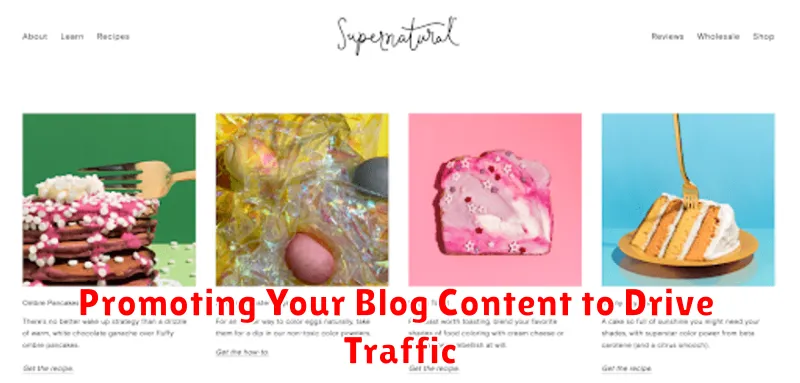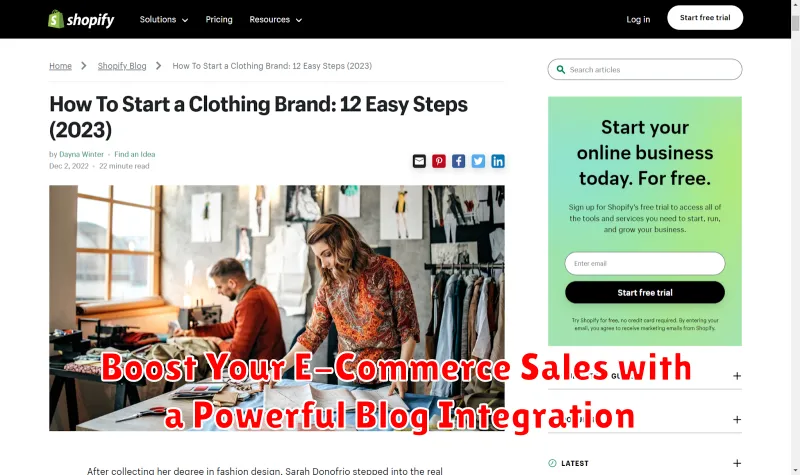In today’s competitive digital landscape, a robust online presence is crucial for e-commerce success. Simply having an online store is no longer enough. To truly thrive, you need to attract, engage, and convert potential customers. One of the most effective ways to achieve this is through blog integration. By seamlessly weaving a blog into your e-commerce platform, you can unlock a powerful tool to drive traffic, boost sales, and establish your brand as an industry authority. This article will explore the numerous benefits of e-commerce blog integration and provide actionable strategies for maximizing your return on investment.
E-commerce sales are directly influenced by visibility, engagement, and customer trust. A strategically implemented blog can significantly enhance all three of these critical elements. Through compelling content creation focused on relevant keywords related to your products and industry, you can improve your search engine rankings, drawing more organic traffic to your e-commerce store. Furthermore, a blog provides a platform to build relationships with your target audience, fostering loyalty and driving conversions. Learn how to harness the power of blog integration to propel your e-commerce sales to new heights.
Why Integrate a Blog with Your E-Commerce Website?
Integrating a blog with your e-commerce platform offers a multitude of benefits that can significantly impact your bottom line. A blog isn’t just a place to share updates; it’s a powerful tool to attract, engage, and convert customers.
Increased Organic Visibility: Fresh, relevant blog content boosts your search engine rankings. By targeting keywords related to your products, you attract potential customers actively searching for information and solutions.
Enhanced Customer Engagement: Blogs provide a platform to connect with your audience on a deeper level. Sharing valuable content builds trust and positions your brand as an authority in your industry.
Drive Traffic to Product Pages: Strategically placed calls to action within your blog posts can guide readers to relevant product pages, increasing the likelihood of conversions.
Establish Brand Authority: By consistently providing informative and insightful content, you build credibility and position your brand as a trusted resource.
Improved Customer Retention: Engage existing customers with valuable content that keeps them coming back for more. This fosters loyalty and encourages repeat purchases.
Choosing the Right Blogging Platform
Selecting the right blogging platform is crucial for a seamless integration with your e-commerce website. Consider factors like ease of use, scalability, and integration capabilities.
For businesses already using a platform like Shopify, using their built-in blogging features can be a simple and effective solution. This offers a centralized management system for both your products and content.
Alternatively, WordPress is a popular choice due to its flexibility and extensive plugin library, allowing for customization and seamless integration with various e-commerce platforms. Other platforms like Squarespace and Wix also offer blogging functionality, making them viable options depending on your specific needs and technical expertise.
Evaluating factors such as cost, SEO features, and design customization options will help you choose the platform that best aligns with your e-commerce goals.
Creating High-Quality Blog Content
High-quality content is the cornerstone of a successful blog. It’s what attracts readers, keeps them engaged, and ultimately drives conversions. Focus on creating informative, valuable, and entertaining pieces that resonate with your target audience.
Start by understanding your ideal customer. What are their pain points? What are their interests? What kind of information are they searching for? Answering these questions will guide your content creation process.
Keywords play a crucial role in content discovery. Research relevant keywords related to your products and incorporate them naturally within your blog posts. Avoid keyword stuffing, as this can negatively impact your search engine rankings.
Consider different content formats to keep your blog fresh and engaging. Product reviews, tutorials, behind-the-scenes looks, and listicles are just a few examples. Experiment to see what resonates best with your audience.
Finally, ensure your content is well-written and error-free. Proper grammar, spelling, and punctuation contribute to a professional image and build trust with your readers.
Optimizing Your Blog for Search Engines
Optimizing your blog for search engines, also known as SEO, is crucial for attracting organic traffic and potential customers. By strategically incorporating relevant keywords and following SEO best practices, you can improve your blog’s visibility in search engine results pages (SERPs).
Keyword Research: Identify relevant keywords that potential customers are searching for. Use keyword research tools to find keywords with high search volume and low competition. Incorporate these keywords naturally within your blog posts, including in the title, headings, and body.
On-Page Optimization: Optimize each blog post for specific keywords. Use descriptive, keyword-rich URLs. Write compelling meta descriptions that accurately reflect the content of your blog post and entice users to click.
Technical SEO: Ensure your blog is technically sound for search engines. Optimize your website’s loading speed, ensure it’s mobile-friendly, and submit your sitemap to search engines.
Promoting Your Blog Content to Drive Traffic

Driving traffic to your blog requires a multi-faceted approach. Social media is a powerful tool. Share your blog posts across platforms like Facebook, Instagram, X (formerly Twitter), and LinkedIn, tailoring your message to each audience. Engage with comments and participate in relevant discussions to expand your reach.
Email marketing is another effective strategy. Build an email list and send out regular newsletters featuring your latest blog posts. Segment your list to provide targeted content and increase engagement. Personalized email campaigns can drive significant traffic back to your site.
Consider leveraging influencer marketing. Partnering with relevant influencers in your niche can expose your blog to a wider audience. Influencers can share your content with their followers, increasing brand awareness and driving traffic.
Don’t forget about paid advertising. Platforms like Google Ads and social media advertising can effectively target specific demographics interested in your products or content. While requiring a budget, paid advertising can deliver immediate results.
Integrating Your Blog Seamlessly with Your Online Store
A seamless blog integration enhances the customer journey and drives sales. Key considerations include platform compatibility and user experience.
Choose a blogging platform that integrates easily with your e-commerce platform. Some platforms offer built-in blogging functionality, while others require third-party integrations. Ensure the chosen platform supports your technical requirements and offers customization options.
Design and navigation are crucial. The blog should visually align with your online store’s branding and aesthetics. Incorporate clear navigation links between your blog and product pages. Promote relevant products within blog posts through contextualized calls to action.
Consider using product widgets or related product sections within blog posts. This allows customers to easily browse and purchase products mentioned in the content, streamlining the path to purchase.
Measuring the Success of Your Blog Integration
Tracking the effectiveness of your blog integration is crucial for optimizing its performance and ensuring it contributes to your business goals. Several key metrics can provide valuable insights into the success of your integration.
Firstly, monitor website traffic originating from your blog. This reveals how effectively your blog content is driving customers to your online store. Track referral traffic specifically from your blog to pinpoint which posts are generating the most interest.
Next, analyze conversion rates. This involves measuring how many blog visitors ultimately make a purchase. A high conversion rate indicates a strong connection between your blog content and customer purchase decisions. Time spent on page and bounce rate can also provide valuable context. A low bounce rate and high time spent on page suggests engaging content that resonates with your target audience.
Finally, track social media engagement. Measure shares, likes, and comments related to your blog posts to gauge audience interest and the virality of your content. This metric reflects the reach and impact of your blog beyond your immediate website traffic.
Common Mistakes to Avoid When Integrating a Blog
Integrating a blog with your e-commerce store can be a powerful strategy, but some common mistakes can hinder its effectiveness. Avoiding these pitfalls will help you maximize your blog’s potential.
Neglecting SEO: A common oversight is failing to optimize blog content for search engines. Keyword research and proper on-page optimization are crucial for attracting organic traffic.
Irrelevant Content: Publishing content unrelated to your products or target audience is another mistake. Your blog should provide valuable information related to your offerings, establishing you as an authority and attracting potential customers.
Inconsistent Posting: Sporadic posting can lead to a loss of reader interest. Establish a consistent posting schedule to keep your audience engaged and coming back for more.
Ignoring Promotion: Simply publishing content isn’t enough. Actively promote your blog posts across social media and other channels to reach a wider audience.
Lack of Call to Action: Don’t forget to guide readers towards desired actions. Include clear calls to action in your blog posts, encouraging readers to explore your products or engage further with your brand.
Examples of Successful E-Commerce Blogs
Examining successful e-commerce blogs can provide valuable insights for your own integration. Several companies have effectively leveraged blog content to drive sales and engagement. Consider these examples:
Example 1: The Fashion Retailer
This retailer’s blog focuses on style guides, trend reports, and behind-the-scenes looks at their design process. This approach builds brand loyalty and positions them as a fashion authority, driving traffic back to their product pages.
Example 2: The Tech Company
This tech company’s blog prioritizes in-depth product reviews, tutorials, and comparisons. This caters to their tech-savvy audience, offering valuable information that ultimately encourages purchases.
Example 3: The Home Goods Store
This online store uses its blog to share interior design inspiration, DIY project ideas, and product spotlights. This creates a lifestyle connection with their customers, encouraging them to envision their products in their own homes.
Leveraging User-Generated Content for Your Blog

User-generated content (UGC) can be a powerful tool to enrich your e-commerce blog and build a stronger community. By featuring content created by your customers, you demonstrate that you value their opinions and experiences, fostering trust and loyalty.
Encourage customers to share their product experiences through reviews, photos, and videos. Run contests or offer incentives for the best submissions. Highlighting this content on your blog provides authentic social proof, influencing potential buyers more effectively than traditional advertising.
Moderating UGC is crucial. Establish clear guidelines for submissions to maintain quality and ensure alignment with your brand. Respond to comments and engage with contributors to cultivate a sense of belonging within your online community.
Examples of UGC include customer testimonials, product reviews, style guides featuring your products, and unboxing videos. By incorporating these diverse formats, you create a dynamic and engaging blog experience that resonates with your target audience and boosts sales.

